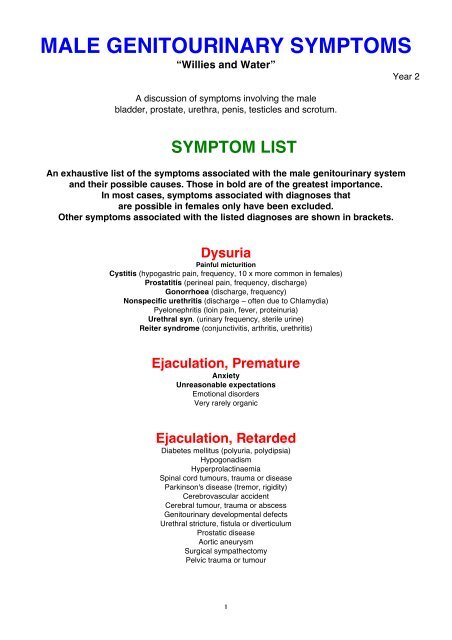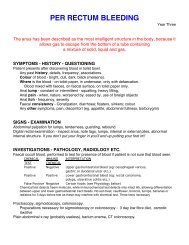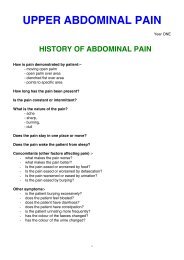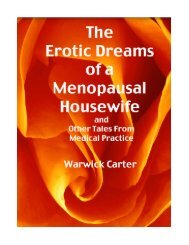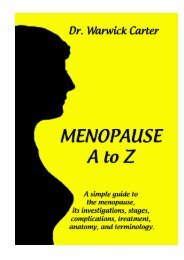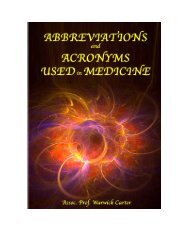MALE GENITOURINARY SYMPTOMS - Medwords.com.au
MALE GENITOURINARY SYMPTOMS - Medwords.com.au
MALE GENITOURINARY SYMPTOMS - Medwords.com.au
Create successful ePaper yourself
Turn your PDF publications into a flip-book with our unique Google optimized e-Paper software.
<strong>MALE</strong> <strong>GENITOURINARY</strong> <strong>SYMPTOMS</strong><br />
“Willies and Water”<br />
Year 2<br />
A discussion of symptoms involving the male<br />
bladder, prostate, urethra, penis, testicles and scrotum.<br />
SYMPTOM LIST<br />
An exh<strong>au</strong>stive list of the symptoms associated with the male genitourinary system<br />
and their possible c<strong>au</strong>ses. Those in bold are of the greatest importance.<br />
In most cases, symptoms associated with diagnoses that<br />
are possible in females only have been excluded.<br />
Other symptoms associated with the listed diagnoses are shown in brackets.<br />
Dysuria<br />
Painful micturition<br />
Cystitis (hypogastric pain, frequency, 10 x more <strong>com</strong>mon in females)<br />
Prostatitis (perineal pain, frequency, discharge)<br />
Gonorrhoea (discharge, frequency)<br />
Nonspecific urethritis (discharge – often due to Chlamydia)<br />
Pyelonephritis (loin pain, fever, proteinuria)<br />
Urethral syn. (urinary frequency, sterile urine)<br />
Reiter syndrome (conjunctivitis, arthritis, urethritis)<br />
Ejaculation, Premature<br />
Anxiety<br />
Unreasonable expectations<br />
Emotional disorders<br />
Very rarely organic<br />
Ejaculation, Retarded<br />
Diabetes mellitus (polyuria, polydipsia)<br />
Hypogonadism<br />
Hyperprolactinaemia<br />
Spinal cord tumours, tr<strong>au</strong>ma or disease<br />
Parkinson's disease (tremor, rigidity)<br />
Cerebrovascular accident<br />
Cerebral tumour, tr<strong>au</strong>ma or abscess<br />
Genitourinary developmental defects<br />
Urethral stricture, fistula or diverticulum<br />
Prostatic disease<br />
Aortic aneurysm<br />
Surgical sympathectomy<br />
Pelvic tr<strong>au</strong>ma or tumour<br />
1
<strong>MALE</strong> <strong>GENITOURINARY</strong> <strong>SYMPTOMS</strong><br />
Ejaculation, Retrograde<br />
Psychological stress<br />
Prostatectomy<br />
Pelvic surgery or tr<strong>au</strong>ma<br />
Spinal cord tr<strong>au</strong>ma or tumour<br />
Diabetes mellitus (polyuria, polydipsia)<br />
Congenital abnormalities<br />
Idiopathic<br />
Drugs (eg. clonidine, bethanidine, guanethidine, methyldopa, phenothiazines, thiazides)<br />
Enuresis<br />
Bed wetting<br />
Urinary tract infections (dysuria, hypogastric dis<strong>com</strong>fort, female)<br />
Lifestyle stress (eg. family break-up, maternal separation, hospital admission, moving home)<br />
Social pressures (eg. poverty, overcrowding, lack of privacy)<br />
Excessively strict toilet training<br />
Intellectual disability<br />
Congenitally small bladder<br />
Diabetes mellitus (polydipsia, polyuria)<br />
Diabetes insipidus<br />
Renal insufficiency<br />
Epilepsy<br />
Spina bifida<br />
Other neurological disorders<br />
Familial<br />
Haematospermia<br />
(Haemospermia)<br />
Blood in ejaculated semen<br />
Idiopathic<br />
Infrequent sexual intercourse<br />
Tr<strong>au</strong>ma to penis or prostate (eg. masturbation, excess sex)<br />
Prostatitis (tender prostate on examination)<br />
Seminal vesciculitis<br />
Coagulopathies (easy bruising)<br />
Prostatic carcinoma<br />
Haematuria and Red Urine<br />
Urinary blood<br />
Blood In Urine<br />
Urinary tract infections of any type<br />
Glomerulonephritis (oliguria, oedema, headache)<br />
Renal and ureteric stones (severe pain, n<strong>au</strong>sea)<br />
Bladder or renal tumours (pain)<br />
Renal or bladder tr<strong>au</strong>ma<br />
Extremely vigorous exercise<br />
Anticoagulant therapy<br />
Polycystic kidneys<br />
Cytomegalovirus (j<strong>au</strong>ndice, neonate, purpura)<br />
Blackwater fever (severe form of malaria)<br />
Bilharzia (urticaria, frequency, fever)<br />
Renal tuberculosis<br />
2
<strong>MALE</strong> <strong>GENITOURINARY</strong> <strong>SYMPTOMS</strong><br />
Analgesic nephropathy (history of <strong>com</strong>pound analgesics)<br />
Haemoglobinuria<br />
Acute renal failure (oliguria, n<strong>au</strong>sea)<br />
Haemophilia (melaena, excessive bleeding, ecchymoses)<br />
Alport syn. (deaf)<br />
Goodpasture syn. (haemoptysis)<br />
Haemolytic-uraemic syn. (anaemia, thrombocytopenia)<br />
Henoch-Schoenlein syn. (purpura, abdominal pain)<br />
Thin basement membrane disease [idiopathic haematuria](asymptomatic)<br />
Nonblood C<strong>au</strong>ses<br />
Porphyria (urine turns red when left standing)<br />
Phenolphthalein and vegetable dyes (eg. fava beans, beetroot)<br />
Heavy urate concentration (pink)\<br />
Drugs (eg. warfarin, heparin, pyridium, aspirin, cyclophosphamide, carbidopa, phenindione, metronidazole)<br />
Impotence<br />
Lack of male potency and libido<br />
Psychogenic<br />
Pituitary adenoma<br />
Addison's disease (fatigue, anaemia, irritable)<br />
Testicular disease or tumours<br />
Diabetes mellitus (polyuria, polydipsia, blurred vision)<br />
Thyrotoxicosis (sweating, fatigue, weight loss)<br />
Alcohol and poisons (eg. lead, mercury)<br />
Panhypopituitarism (fatigue, hypothermia)<br />
Hypothyroidism<br />
Hyperprolactinaemia<br />
Multiple sclerosis (weakness, abnormal sensation)<br />
Hypogonadism (tall, shrill voice, hairless)<br />
Atherosclerosis<br />
Hypercholesterolaemia<br />
Pelvic or penile arterial obstruction<br />
Hypertension<br />
Prostatic carcinoma<br />
Prostatectomy<br />
Multiple sclerosis<br />
Peyronie's disease<br />
Paraplegia<br />
Fractured penis (haematoma)<br />
Depression (insomnia, loss of interest)<br />
Fractured pelvis<br />
Drugs (eg. antihypertensives, sedatives, tricyclics, clofibrate, cimetidine, thiazides, spironolactone, beta-blockers,<br />
digoxin, nicotine, marijuana)<br />
Cushing syn. (obese, hirsute, ecchymoses)<br />
Fröhlich syn. (thin skin, scanty hair, obese)<br />
Klinefelter syn. (delayed puberty, hypoplastic genitalia)<br />
Lariche syn. (cl<strong>au</strong>dication, poor pulses)<br />
Incontinence of Urine<br />
Enuresis<br />
Urinary tract infections (dysuria, frequency, fever)<br />
Cerebrovascular accidents (neurological signs)<br />
Senility (confusion of old age)<br />
3
<strong>MALE</strong> <strong>GENITOURINARY</strong> <strong>SYMPTOMS</strong><br />
Bladder distension due to partial obstruction<br />
Diabetes mellitus (polydipsia, polyuria)<br />
Diabetes insipidus (polydipsia, polyuria)<br />
Renal failure<br />
Faecal impaction<br />
Parkinson's disease (tremor, shuffling gait)<br />
Spinal cord injuries, disease and tumours<br />
Neurogenic bladder<br />
Bladder tumour or stone (haematuria)<br />
Anaphylaxis<br />
Hypercalcaemia<br />
Multiple sclerosis (diffuse neurological anomalies)<br />
Reactive depression (anxiety, agitation, anger)<br />
Shock (eg. anaphylaxis)<br />
Loss of consciousness (eg. convulsions)<br />
Alcohol excess<br />
Drugs (eg. alpha -blockers, caffeine, hypnotics, lithium, tranquillizers, diuretics, tricyclic antidepressants)<br />
Detrusor hyperactivity (urgency incontinence)<br />
Libido, Reduced<br />
Reduced desire for sexual activity<br />
Both sexes<br />
Psychological stress<br />
Pituitary disease (eg. adenoma)<br />
Hyperprolactinaemia<br />
Hypothyroidism (constipation, hoarse, dry skin)<br />
Addison's disease (pigmentation, fatigue, n<strong>au</strong>sea)<br />
Diabetes mellitus (polyuria, polydipsia)<br />
Cerebrovascular accident<br />
Parkinson's disease (tremor, rigidity)<br />
Cerebral space occupying lesions<br />
Psychiatric disease (eg. depression)<br />
Chronic renal failure<br />
Chronic hepatic failure<br />
Carcinoid syn. (flushing)<br />
Cushing syn. (obese, striae)<br />
Malignancies<br />
Drugs (eg. alcohol, steroids, antihistamines, benzodiazepines, antihypertensives, diuretics)<br />
Male<br />
Testicular atrophy or disease<br />
Androp<strong>au</strong>se<br />
Prostate infection or enlargement<br />
Female<br />
Climacteric syn. (menop<strong>au</strong>sal symptoms)<br />
Stage of menstrual cycle<br />
Pregnancy<br />
Nocturia<br />
Nocturnal Polyuria<br />
Renal insufficiency<br />
Congestive cardiac failure (dyspnoea, oedema)<br />
Venous insufficiency (oedema)<br />
Hypoalbuminaemia<br />
Idiopathic<br />
4
<strong>MALE</strong> <strong>GENITOURINARY</strong> <strong>SYMPTOMS</strong><br />
Excesive fluid intake.<br />
Drugs (eg. long acting diuretics, alcohol, caffeine)<br />
Diurnal Polyuria<br />
Diabetes mellitus (thirst, tiredness)<br />
Diabetes insipidus<br />
Hypercalcaemia<br />
Psychogenic<br />
Drugs (eg. psychotropics)<br />
Reduced Bladder Capacity<br />
Cystitis (dysuria)<br />
Cerebrovascular accident<br />
Parkinson’s disease (tremor)<br />
Bladder calculi or tumour<br />
Bladder outlet obstruction (eg. prostatomegaly)<br />
Age related<br />
Polyuria and Pollakiuria<br />
Excessive urinary output or frequency<br />
Cystitis (dysuria, hypogastric pain)<br />
Chronic renal failure (in end stage only)<br />
Prostatitis (discharge, pain, dysuria)<br />
Diabetes insipidus (polydipsia, low urine SG)<br />
Diabetes mellitus (fatigue, blurred vision, paraesthesiae)<br />
Hypoparathyroidism (tetany, wheeze, convulsions)<br />
Hyperparathyroidism (polydipsia, bone pain, n<strong>au</strong>sea)<br />
Addison's disease (nocturia, pigmentation, weakness)<br />
SLE (macular rash, polyarthritis)<br />
Hypercalcaemia (constipation, n<strong>au</strong>sea)<br />
Obstructive sleep apnoea (snoring)<br />
Anxiety neurosis<br />
Hand-Schuller-Christian disease (eczema, adenitis)<br />
Acromegaly (coarse features, back pain, psychoses)<br />
Hyperaldosteronism (polydipsia, weakness, tetany)<br />
Bilharzia (urticaria, fever, haematuria)<br />
Drugs (eg. lead, diuretics)<br />
Bartter syn. (child, short, polydipsia)<br />
Cushing syn. (obese, moon face, striae)<br />
Diencephalic syn. (cachexia, vomiting, pallor)<br />
Potassium wastage syn. (weak, hypokalaemia)<br />
Urethral syn. (dysuria, sterile urine)<br />
Urge syn. (nocturia, urge incontinence)<br />
Priapism<br />
Painful, persistent penile erection<br />
Penile tr<strong>au</strong>ma<br />
Bladder calculus<br />
Spinal cord lesions<br />
Leukaemia<br />
Polycythaemia rubra vera<br />
Multiple myeloma<br />
Cerebrovascular accident (CNS signs)<br />
Diabetes mellitus (polyuria, polydipsia)<br />
5
<strong>MALE</strong> <strong>GENITOURINARY</strong> <strong>SYMPTOMS</strong><br />
Urethritis (dysuria)<br />
Sickle cell anaemia<br />
Leukaemia (child)<br />
Metastatic carcinoma<br />
Psychiatric disorders<br />
Excess sexual stimulation<br />
Drugs (eg. prazosin, psychotropics, heparin, vasodilators, alcohol, cocaine, marijuana)<br />
Strangury<br />
Very slow, painful micturition<br />
Bladder infection (frequency, hypogastric pain)<br />
Prostatitis<br />
Bladder tumours (haematuria)<br />
Urethritis (dysuria, proteinuria, discharge)<br />
Gonorrhoea (urethral discharge)<br />
Nonspecific urethritis (discharge)<br />
Urethral tumour, tr<strong>au</strong>ma, stone or foreign body<br />
Testicular or Scrotal Mass or Tumour<br />
Testicular carcinoma or teratoma (often painless)<br />
Hydrocele (transilluminates)<br />
Spermatocele (above and behind testes, transilluminates)<br />
Inguinal hernia (continuous with abdomen)<br />
Torted testes (severe pain, n<strong>au</strong>sea)<br />
Epididymo-orchitis (pain, fever)<br />
Epididymal cyst<br />
Syphilitic gumma (solid)<br />
Haematoma<br />
Varicocele (above testes, soft)<br />
Idiopathic scrotal oedema (erythema, slight pain)<br />
Acute leukaemia (abnormal WCC, malaise)<br />
Filariasis (elephantiasis) (adenitis, fever)<br />
Fragile X syn. (subnormal intelligence, epilepsy, testis enlarged)<br />
Testicular or Scrotal Pain<br />
Epididymo-orchitis (pain, fever, bacterial or viral)<br />
Torted testes (severe pain, n<strong>au</strong>sea, oedema)<br />
Torted testicular appendage [torted hydatid of Morgagni] (prepubertal, testes palpable)<br />
Testicular tumour (firm, gynae<strong>com</strong>astia)<br />
Mumps orchitis (parotid pain and swelling, fever)<br />
Gonorrhoea (discharge, dysuria)<br />
Filariasis (oedema, fever, adenitis)<br />
Brucellosis (fever, myalgia, confusion)<br />
Referred pain from back or ureter<br />
Urethral Discharge<br />
Prostatitis (dysuria, frequency, pain)<br />
Gonorrhoea (dysuria, milky discharge)<br />
Nonspecific urethritis [Chlamydia ]<br />
Mycoplasma / Ureoplasma infection<br />
6
<strong>MALE</strong> <strong>GENITOURINARY</strong> <strong>SYMPTOMS</strong><br />
Urinary Retention and Difficult Micturition<br />
Prostatic hyperplasia (poor stream, infection)<br />
Prostatic carcinoma (back pain, renal failure)<br />
Bladder tumours (haematuria, pain)<br />
Bladder calculus or blood clot<br />
Foreign body in urethra or bladder<br />
Urethral stricture or tumour<br />
Neurogenic bladder<br />
Typhoid fever (abdominal tenderness, cough)<br />
Stress and anxiety<br />
AN EXPLANATION OF THE<br />
MOST SIGNIFICANT DISEASES LISTED ABOVE<br />
BILHARZIA (SCHISTOSOMIASIS)<br />
Schistosomiasis (bilharzia) is a fluke infestation transmitted by a species of snail that is found in fresh water<br />
streams, rivers and lakes in Egypt, tropical Africa as far south as Zimbabwe, the Caribbean and eastern South<br />
America. It is often c<strong>au</strong>ght by bathing or washing in fresh water.<br />
The c<strong>au</strong>se is a microscopic animal (trematode fluke) that enters the body by burrowing through the skin,<br />
often of the foot. Three different flukes - Schistosoma mansoni, Schistosoma japonicum, and Schistosoma mekongi<br />
- may be responsible.<br />
Once in the blood it travels to the veins around the large intestine, where eggs are laid. These pass out with<br />
the faeces or urine to infect water supplies. Once in fresh water, the eggs hatch, and the larvae seek out and<br />
burrow into the flesh of specific species of fresh water snail. They mature in the snail, and emerge from it ready to<br />
enter and infect another human.<br />
Patients do not pass out all the eggs that are laid by the fluke, and they may spread to the liver, lungs or<br />
spinal cord to c<strong>au</strong>se further symptoms. Damage c<strong>au</strong>sed to organs by the fluke may be permanent.<br />
The first symptom is an itchy patch at the site of skin penetration. Varying symptoms then follow, depending<br />
on the areas affected by the fluke as it moves through the body, and the individual's reaction to those changes.<br />
Long-term symptoms include diarrhoea, abdominal pain and bloody urine. A particularly severe and rapidly<br />
progressive form of the disease is known as Katayama Fever.<br />
The diagnosis involves blood, urine and skin tests, and liver and gut biopsies.<br />
Treatment is difficult, particularly late in the disease, although a number of drugs (eg. praziquantel) can be<br />
used to kill the fluke inside the body. Untreated it may c<strong>au</strong>se a low-grade chronic illness, or may progress to death<br />
7
<strong>MALE</strong> <strong>GENITOURINARY</strong> <strong>SYMPTOMS</strong><br />
in a matter of months. The results of treatment are good if <strong>com</strong>menced early in the course of the disease, but<br />
advanced disease may be incurable.<br />
CYSTITIS<br />
Cystitis is an infection of the urinary bladder that usually occurs in women, with less than 10% occurring in<br />
men bec<strong>au</strong>se the longer length of their urethra (the tube leading from the bladder to the outside).<br />
A bacterial infection can enter the bladder by <strong>com</strong>ing up the urethra from outside the body, or through the<br />
bloodstream to the kidneys and then the bladder. Entry from the outside is far more <strong>com</strong>mon, and often due to<br />
irritation of the urethra with sex. Slackness of the muscle ring that controls the release of urine from the bladder can<br />
also allow bacteria to enter the bladder. This damage may be c<strong>au</strong>sed by childbirth or prolapse of the womb, and<br />
may eventually c<strong>au</strong>se incontinence with a cough or l<strong>au</strong>gh.<br />
The symptoms include burning pain on passing urine, pain in the pelvis, the desire to pass urine very<br />
frequently and blood may be seen in the urine. The infection may spread up the ureters to the kidneys to c<strong>au</strong>se<br />
acute pyelonephritis.<br />
The urine can be cultured to identify the responsible bacteria and correct antibiotic. Further investigations<br />
such as X-rays and ultrasound scans of the bladder and kidneys may be performed, to exclude more serious<br />
c<strong>au</strong>ses of recurrent cystitis.<br />
Appropriate antibiotic tablets for a week or two, and urinary alkalinisers (in the form of a powder that makes a<br />
fizzy drink) result in a rapid cure in most patients. Drinking extra fluid will help wash the infection out of the bladder,<br />
while passing urine immediately after sex sometimes prevents infections.<br />
Commercial urinary alkalinisers or cranberry juice may be used regularly to prevent cystitis in women who<br />
have this problem regularly.<br />
EPIDIDYMO-ORCHITIS<br />
Epididymo-orchitis is a bacterial or viral infection of the testicle and epididymis. The sperm produced in a<br />
testicle passes into a dense network of fine tubes that forms a lump on the back of the testicle called the<br />
epididymis. These join up to form the sperm tube (vas deferens) that takes the sperm to the penis. Epididymoorchitis<br />
is an infection of both the epididymis and testicle. Orchitis is an infection of the testicle alone, but the<br />
infection is almost invariably present in both places.<br />
Men with a bacterial epididymo-orchitis are acutely un<strong>com</strong>fortable, have a painful swollen testicle, and a<br />
fever. Occasionally an abscess will form, which must be surgically drained. A painful testicle can also be c<strong>au</strong>sed by<br />
torsion of the testis, which is a surgical emergency requiring immediate treatment. Any boy or man, particularly in<br />
the teenage years or early twenties, who develops a painful testicle, must see a doctor immediately - day or night.<br />
Blood tests may show the presence of infection in the body, and treatment involves appropriate antibiotics,<br />
aspirin or paracetamol for pain relief, ice may be applied to the scrotum, and a supportive bandage or jockstrap<br />
worn. If the infection is c<strong>au</strong>sed by a virus such as mumps, there is no effective treatment available. With the correct<br />
treatment, bacterial epididymo-orchitis resolves in a couple of days, and usually does not c<strong>au</strong>se any problems with<br />
fertility or masculinity. In cases of viral infection there may be problems with fertility in later life.<br />
GONORRHOEA<br />
Gonorrhoea (“clap”) is a <strong>com</strong>mon sexually transmitted bacterial infection c<strong>au</strong>sed by the bacterium Neisseria<br />
gonorrhoeae, which can only be c<strong>au</strong>ght by having sex with a person who already has the disease. It has an<br />
incubation period of three to seven days after contact. Some degree of protection can be obtained by using a<br />
condom.<br />
8
<strong>MALE</strong> <strong>GENITOURINARY</strong> <strong>SYMPTOMS</strong><br />
The symptoms vary significantly between men and women.<br />
In women there may be minimal symptoms with a mild attack, but when symptoms do occur they include a foul<br />
discharge from the vagina, pain on passing urine, pain in the lower abdomen, passing urine frequently, tender<br />
lymph nodes in the groin, and fever. If left untreated the infection can involve the uterus and Fallopian tubes to<br />
c<strong>au</strong>se salpingitis and pelvic inflammatory disease, which can result in infertility and persistent pelvic pain. Babies<br />
born to mothers with the infection can develop gonococcal conjunctivitis (eye infection).<br />
In men symptoms are usually obvious with a yellow milky discharge from the penis, pain on passing urine and,<br />
in advanced cases, inflamed lymph nodes in the groin. If left untreated the prostate can be<strong>com</strong>e infected, which<br />
can c<strong>au</strong>se scarring of the urine tube (urethra), permanent difficulty in passing urine and reduced fertility.<br />
With anal intercourse, a rectal infection with gonorrhoea can develop and c<strong>au</strong>se an anal discharge, mild<br />
diarrhoea, rectal dis<strong>com</strong>fort and pain on passing faeces.<br />
Oral sex can lead to the development of a gonococcal throat infection.<br />
Gonorrhoea may also enter the bloodstream and c<strong>au</strong>se septicaemia. An unusual <strong>com</strong>plication is gonococcal<br />
arthritis, which c<strong>au</strong>ses pain in the knees, ankles and wrists. Other rarer <strong>com</strong>plications include infections of the<br />
heart, brain and tendons.<br />
The diagnosis is confirmed by examining a swab from the urethra, vagina or anus under a microscope, and<br />
culturing the bacteria on a nutrient substance. There are no blood tests available to diagnose gonorrhoea. Other<br />
sexually transmitted diseases should also be tested for when gonorrhoea is diagnosed, as they may be contracted<br />
at the same time. For this reason, blood tests are often ordered when treating anyone with any form of venereal<br />
disease.<br />
Gonorrhoea has been readily treated with a course of penicillin until recently, but many strains are now<br />
resistant to penicillin and more potent antibiotics (eg. spectinomycin) are required. All sexual contacts of the<br />
infected person need to be notified as they may be carriers of the disease and unaware of the presence of the<br />
infection. After treatment, a follow-up swab is important to ensure that the infection has been adequately treated.<br />
The appropriate antibiotics can cure more than 95% of gonorrhoea cases.<br />
IMPOTENCE - PSYCHOGENIC<br />
Impotence is the inability of a man to obtain a firm erection of the penis when sexually stimulated. It is a very<br />
<strong>com</strong>mon problem, and something that every man experiences at some time, particularly in middle age and older.<br />
The process of erection sometimes mystifies women. It is one over which the man has no direct control, as it is<br />
a local reflex in the pelvis triggered by sexual excitement. A man even has difficulty in detecting if his penis is erect<br />
unless it is touched or seen. The penis contains two s<strong>au</strong>sage shaped sponge filled tubes (corpora cavernosa) that<br />
fill with blood under pressure when a muscular ring closes off the drainage veins behind the base of the penis.<br />
A wide range of diseases may c<strong>au</strong>se impotence, and these must be excluded by appropriate investigations<br />
before a psychological c<strong>au</strong>se is diagnosed, or impotence treatment is given. If a c<strong>au</strong>se is found, that should be<br />
specifically treated to resolve the problem. Only if no particular c<strong>au</strong>se can be diagnosed should the various<br />
impotence treatments available be used.<br />
A lot of impotence is c<strong>au</strong>sed by a psychological feedback mechanism. For one of the reasons listed below, a<br />
man may fail to develop an erection when attempting sex. He feels embarrassed and ashamed about this,<br />
particularly if it is with a new partner. The next time he tries to have sex he will be anxious as to whether he will be<br />
able to perform. This anxiety makes him concentrate on trying to get an erection, which is an almost certain way in<br />
which to prevent an erection. After two failures, the anxiety increases, which further decreases the chance of<br />
success at subsequent attempts. It requires the patient understanding of the man’s partner and the continuing<br />
advice of a doctor, to over<strong>com</strong>e this erection failure cycle.<br />
Common c<strong>au</strong>ses of impotence include the overuse of alcohol (which increases the desire, while reducing the<br />
ability), stress and anxiety in any aspect of life, difficult circumstances (eg. lack of privacy), heavy smoking, illegal<br />
drugs (eg. marijuana, heroin) and medications (eg. those used to lower blood pressure and improve depression,<br />
sedatives, cimetidine, clofibrate, digoxin).<br />
Other possible c<strong>au</strong>ses of impotence include depression, pituitary gland disease (gland in the brain which<br />
controls all other glands including the testes), testicular diseases or injury, poorly controlled diabetes mellitus<br />
(sugar diabetes), high levels of cholesterol may c<strong>au</strong>se hardening of the arteries (atherosclerosis) and make it<br />
difficult for the blood to get into the penis and cancer of the prostate gland may interfere with the normal nerve and<br />
blood vessel reflexes that allow an erection.<br />
Rare c<strong>au</strong>ses of impotence include Peyronie disease (a replacement of the blood filled sacs by fibrous scar<br />
tissue), a “fracture” of the erect penis, multiple sclerosis, paraplegia and quadriplegia, lead poisoning, Klinefelter<br />
syndrome) and Fröhlich syndrome.<br />
Psychological factors may be over<strong>com</strong>e by not planning sex, but relaxing and waiting until the right<br />
circumstances occur spontaneously. Mutual heavy petting and erotic stimulation, but without the expectation of sex,<br />
sexual toys, pornography and vacuum pumps to create an erection may be used. Once spontaneous erections<br />
9
<strong>MALE</strong> <strong>GENITOURINARY</strong> <strong>SYMPTOMS</strong><br />
develop, sex may start again. Numerous medications are also available including:-<br />
- alprostadil (Caverject) injections into the penis<br />
- alprostadil (Muse)pellets may be inserted into the urethra (urine tube in the penis)<br />
- sildenafil (Viagra), tadalafil (Cialis) and vardenafil (Levitra) tablets.<br />
Several other medications are under development (eg. apomorphine).<br />
KLINEFELTER SYNDROME<br />
The Klinefelter syndrome (XXY syndrome) is a congenital sexual abnormality that affects one in every 500<br />
males. The chromosomes from the mother and father of these men <strong>com</strong>bine incorrectly with two X chromosomes<br />
and one Y being present (XXY) instead of one of each (XY). Patients have very small testes and penis, small<br />
breasts develop, they have scanty body hair, and are impotent and sterile. It is diagnosed by chromosomal analysis<br />
of blood sample.<br />
Testosterone (male hormone) tablets or injections can be given to improve the body shape and impotence<br />
and plastic surgery to remove the breasts is sometimes necessary, but the infertility cannot be corrected and no<br />
cure is possible.<br />
NON-SPECIFIC URETHRITIS<br />
Non-specific urethritis (NSU) is also known as Chlamydial urethritis and non-Gonococcal urethritis (NGU),<br />
and is a sexually transmitted disease that is carried by women and infects men. Most (but not all) cases of NSU are<br />
c<strong>au</strong>sed by a Chlamydial infection, while unidentified bacteria are responsible for the other cases. Chlamydiae are a<br />
group of organisms that are not bacteria, but act as parasites inside human cells and eventually destroy the cell.<br />
They are spread by passing from a man to his female sexual partners, where it remains in the vagina to infect the<br />
woman’s next sex partner. In homosexuals, the infection may occur around the anus.<br />
Men have a white discharge from the penis, painful passing of urine, but rarely other symptoms, although<br />
sometimes the infection may spread from the penis up into the testes or prostate gland. In women there are<br />
usually no symptoms, but sometimes the infection may spread to c<strong>au</strong>se salpingitis (infection of the Fallopian<br />
tubes).<br />
Chlamydiae may be identified by specific blood and swab tests, but they are not always reliable, and a<br />
negative test does not mean that the infection is not present.<br />
Antibiotics such as tetracyclines and macrolides (eg. azithromycin) are used very successfully in treatment,<br />
and all sexual contacts should be treated when the infection is discovered.<br />
PROSTATE GLAND<br />
The prostate gland is situated behind the base of the penis. The bladder is above and behind the gland, and the<br />
tube that carries urine from the bladder to the outside (the urethra) passes through the centre of the prostate. It is<br />
found only in men and there is no female equivalent.<br />
The prostate is about the size of a golf ball and consists of glands, fibrous tissue and muscle. Its primary<br />
purpose is to produce a substance that makes up part of the semen a man ejaculates during sexual intercourse.<br />
10
<strong>MALE</strong> <strong>GENITOURINARY</strong> <strong>SYMPTOMS</strong><br />
This substance is essential for the nutrition of the sperm as they try to fertilise an egg in the woman. Most men are<br />
totally unaware of the presence of the prostate unless it c<strong>au</strong>ses trouble.<br />
In younger men, the most <strong>com</strong>mon c<strong>au</strong>se of disease is infection, when the gland may swell up and be<strong>com</strong>e very<br />
tender. In older men the disease process is quite different. Up to 20% of all men over 60 may have an enlargement<br />
of the prostate which c<strong>au</strong>ses symptoms, and a small percentage of these may have cancer of the prostate.<br />
Doctors can often diagnose diseases of the prostate by feeling the gland. This involves putting a gloved finger in<br />
the back passage so as to g<strong>au</strong>ge its size and hardness.<br />
PROSTATE GLAND ENLARGED<br />
Unless extraordinarily dextrous, no man can feel his own prostate, as this small organ which sits behind the<br />
base of the penis can only be felt by placing a finger through the anus, where the prostate can be felt as a firm<br />
lump on the front wall of the rectum (last part of the large bowel).<br />
The prostate is about the size of a golf ball and consists of glands, fibrous tissue and muscle. Its produces a<br />
substance that makes up part of the semen a man ejaculates during intercourse that is essential for the nutrition of<br />
the sperm. If the prostate enlarges (prostatomegaly), the patient will have difficulty in starting the urinary stream,<br />
and when it does start, the urine will dribble out onto his shoes, rather than jet onto the porcelain. Up to 20% of all<br />
men over 60 have benign enlargement of the prostate gland, which is usually associated with a drop in sexual<br />
activity. The absolute c<strong>au</strong>se unknown, but as the gland enlarges, it squeezes the urethra (urine-carrying tube) that<br />
passes through it, making it steadily harder to urinate.<br />
There are only three c<strong>au</strong>ses for prostate enlargement (prostatomegaly):-<br />
- prostatomegaly (prostate enlargement) is normal with age, and virtually all men over the<br />
age of seventy have some degree of this problem.<br />
- prostate cancer is a very slowly progressing cancer that increases in incidence with age. It<br />
spreads to bone early, and bone pain is the first symptom in some men.<br />
- prostatitis (infection of the gland), often from a sexually transmitted disease, may c<strong>au</strong>se a<br />
temporary swelling and difficulty in passing urine at any age.<br />
With prostate enlargement the man develops increasing difficulty in passing urine, and eventually the urethra<br />
be<strong>com</strong>es <strong>com</strong>pletely blocked, c<strong>au</strong>sing extreme distress as the pressure of urine in the bladder increases. If backpressure<br />
of urine in the bladder be<strong>com</strong>es persistent, kidney damage can occur.<br />
In the acute situation, a flexible tube is passed up the urethra through the penis into the bladder to release<br />
urine, but if this is unsuccessful a large needle must be pushed through the lower wall of the abdomen into the<br />
bladder. In some cases drugs (eg. finasteride, prazosin, terazosin) can be used to shrink the enlarged prostate<br />
slightly. Most cases require surgery once symptoms develop.<br />
The operation can vary from simply dilating the urethra, to making a small cut in the prostate to allow it to<br />
open up slightly (bladder neck incision), scraping away the part of the prostate constricting the urethra by passing a<br />
specially shaped knife up it (transurethral resection of prostate - TURP), or <strong>com</strong>pletely removing the gland. Holium<br />
laser therapy is being used in some centres to burn away part of the gland.<br />
Treatment almost invariably successful, with no subsequent effect on the general health of the patient, but<br />
there is sometimes subsequent sexual dysfunction.<br />
PROSTATE CANCER<br />
Prostate cancer is the <strong>com</strong>monest cancer in humans, while breast cancer <strong>com</strong>es a close second.<br />
Prostate or prostatic cancer describes any one of several different types of cancer of the prostate gland,<br />
depending on which cells in the gland be<strong>com</strong>e cancerous. The c<strong>au</strong>se is unknown, but those who have sex<br />
infrequently may be more susceptible. It is rare before 50 years of age, but up to 20% of all men over 60 may have<br />
an enlargement of the prostate. The percentage of these men whose enlargement is due to cancer steadily<br />
increases with age, with virtually every male over 90 years of age having some degree of prostate cancer.<br />
This is a very slow-growing cancer that may give no symptoms until many years after it has developed.<br />
Symptoms usually start with difficulty in passing urine and difficulty in starting the urinary stream. In advanced<br />
stages there may be spread of cancer to the bones of the pelvis and back.<br />
Specific blood tests can detect most cases, but it is often diagnosed by feeling the gland using a gloved<br />
finger in the back passage. The blood tests are unreliable as there is both a significant false negative and false<br />
positive rate. A series of blood tests measuring the PSA (prostate specific antigen) over a number of months, and<br />
measuring different subtypes of PSA can give a more reliable reading. Only one in three men with a raised PSA will<br />
have prostate cancer, and some men with cancer have a normal PSA.<br />
The diagnosis is confirmed by an ultrasound scan and ultrasound guided biopsy of the gland, which is<br />
performed through the anus. The biopsy process itself may have <strong>com</strong>plications including bleeding and infection.<br />
Unfortunately, a negative biopsy does not mean that cancer is not present, merely that any cancer that is present<br />
11
<strong>MALE</strong> <strong>GENITOURINARY</strong> <strong>SYMPTOMS</strong><br />
may have been missed by the biopsy needle.<br />
There are many treatment options for prostate cancer :-<br />
- No treatment - in elderly or very ill patients when the patient is more likely to die with the disease than<br />
from the disease. Treatment may have an adverse effect on the man’s life.<br />
- Surgery - radical prostatectomy in which the gland is surgically removed. Complications may include<br />
impotence (75%+) and urinary incontinence (25% over all, but severe in 3%).<br />
- Radiotherapy - an external beam of radiation is targeted on the prostate from many different directions in<br />
order to destroy the cancer. Complications may include irritable bowel and bladder, with the frequent use of<br />
one or both.<br />
- Brachytherapy - tiny radioactive particles are injected into the prostate to create radiation, which destroys<br />
the cancer. This may be <strong>com</strong>bined with radiotherapy. The <strong>com</strong>plications are the same as radiotherapy.<br />
- Medication - Antiandrogens (eg. nilutamide, bicalutamide) are used to slow the progress of more<br />
advanced cases of the disease.<br />
- Orchidectomy (removal of the testes) - this was sometimes performed to remove all testosterone from the<br />
man’s body, as this hormone stimulates growth of the cancer. It is now a rare procedure.<br />
Many new treatment regimes are being introduced every year including new hormones, new cytotoxics and<br />
high intensity focused ultrasound.<br />
If the cancer is localised to the gland itself, the five-year survival rate is over 90%. With local spread, the<br />
survival rate drops to about 70%, but with spread to the bone, only 30% of patients survive five years.<br />
PROSTATITIS<br />
Prostatitis is an infection of the prostate gland, which sits behind the base of the penis, by bacteria that may<br />
enter the prostate by moving up the urethra (urine tube) from the outside, from a sexually transmitted infection (eg.<br />
gonorrhoea), or un<strong>com</strong>monly from an infection spreading from other parts of the body.<br />
Pain occurs behind the base of the penis, and there is a discharge from the penis, pain on passing urine,<br />
fever and patients pass urine frequently. The infection may spread to the man's sexual partner, in whom it can<br />
c<strong>au</strong>se pelvic inflammatory disease.<br />
The diagnosis confirmed by taking a swab from the urethra, and identifying the bacteria present, and<br />
treatment requires taking a long course of antibiotics.<br />
Acute case usually settles with treatment, but recurrences are <strong>com</strong>mon and a low-grade persistent infection<br />
may develop, which is difficult to treat.<br />
REITER SYNDROME<br />
Reiter syndrome (reactive arthritis) is an inflammatory condition involving the eyes, urethra and joints. The<br />
c<strong>au</strong>se is unknown, but it is more <strong>com</strong>monly in young men, and often follows a bacterial infection.<br />
It has the unusual and apparently unconnected symptoms of conjunctivitis (eye inflammation), urethritis<br />
(inflammation of the urine tube - the urethra) and arthritis (joint inflammation). Other symptoms that may occur<br />
include mouth ulcers, skin sores, inflammation of the foreskin of the penis and a fever. Rarely, the heart be<strong>com</strong>es<br />
inflamed.<br />
Blood tests are not diagnostic, but indicate presence of inflammation, and X-rays show arthritis in the joints<br />
of the back only after several attacks.<br />
It heals without treatment after a few days or weeks, but the arthritis tends to last longer and recurrences are<br />
<strong>com</strong>mon. The disease course can be shortened by anti-inflammatory drugs such as indomethacin.<br />
TERATOMA<br />
A teratoma (or dermoid cyst in the USA) is an un<strong>com</strong>mon and unusual form of cancer that occurs in the<br />
ovaries or testes. As the ovaries are the source of eggs, and the testes of sperm, that are used for fertilisation and<br />
growth into new humans, the cells (stem cells) in the ovary and testes, when cancerous may develop into many<br />
different types of tissue.<br />
All types of strange tissue may develop in the tumour, including gland tissue, muscle tissue, skin and even<br />
teeth.<br />
In women, symptoms are often minimal until the cancer is quite large, or bleeding occurs into it to c<strong>au</strong>se an<br />
abdominal lump or pain. Men feel a hard, tender lump in a testicle.<br />
The tumour is diagnosed by x-rays, CT scans and biopsy of the tumour. Surgical removal of the cancer and<br />
surrounding tissue is usually all that is necessary, but rarely, an aggressive cancer may be present, that spreads to<br />
other parts of the body. The overall cure rate is close to 90%.<br />
TESTICULAR CANCER<br />
12
<strong>MALE</strong> <strong>GENITOURINARY</strong> <strong>SYMPTOMS</strong><br />
A number of different types of cancer may develop in the testicles. The types include embryomas,<br />
seminomas (most <strong>com</strong>mon and least serious), choriocarcinoma, teratomas, and a number of rarer ones. The<br />
c<strong>au</strong>se is unknown, but it is a rare form of cancer that develops in one in every 50,000 adult men every year. It is<br />
most <strong>com</strong>mon in early adult and middle-age.<br />
The man finds a firm lump, hardening, unusual tenderness or gradual enlargement of the testicle. There is<br />
often no pain, but unusually some patient's develop small breasts due to excess production of female oestrogen by<br />
the tumour. The cancer may spread to the lymph nodes in the groin, the lungs and liver.<br />
Some types of cancer can be detected by blood tests, but any hard lump in the scrotum must be investigated<br />
by ultrasound, and if necessary surgically biopsied, to determine the exact c<strong>au</strong>se.<br />
Treatment involves removing the affected testicle and nearby lymph nodes, followed by irradiation or<br />
cytotoxic drugs depending upon the type of cancer present. Overall the cure rate is over 90%.<br />
TORSION OF THE TESTIS<br />
Torsion of the testis occurs if a testicle, hanging in the scrotum from its network of veins, arteries and nerves,<br />
twists horizontally, and its blood supply is cut off.<br />
Severe testicular pain, tenderness, redness and swelling occur. It usually occurs in teenage boys, and is<br />
almost unknown over 30 years of age.<br />
Testicular torsion is a medical emergency, and the testis will die unless it is surgically untwisted within about<br />
12 hours. Gangrene and death of the testicle will occur if surgery is delayed, necessitating its removal. Infection of<br />
the testes (epididymo-orchitis) can also occur, and may be confused with torsion, but the pain is usually less<br />
severe, the patient is febrile and both testes may be involved.<br />
The prognosis depends on how quickly surgery is undertaken, but few reach surgery in time for the testicle to<br />
be saved. A man is still able to function normally sexually, and is still fertile, with only one testicle.<br />
URETHRAL SYNDROME<br />
The urethral syndrome is an inflammation of the bladder or urethra (tube leading to the outside from the<br />
bladder) without any infection being present. It c<strong>au</strong>ses dis<strong>com</strong>fort on passing urine and increased frequency of<br />
passing urine. Investigations on the urine are all negative.<br />
It may be c<strong>au</strong>sed by minor injury to the urethra during sexual intercourse, bladder tumours, or a prolapse or<br />
irritation of the skin immediately around the opening of the urethra.<br />
Treatment involves ceasing sexual activities for a few weeks, taking urinary alkalinisers and sometimes a<br />
trial of antibiotics in case a low grade infection is present. Persistent cases need to be further investigated by<br />
cystoscopy (looking into the bladder through a fine tube).<br />
URGE SYNDROME<br />
This annoying syndrome affects one in ten adults at some time in their life. The urge syndrome c<strong>au</strong>ses<br />
patients to pass urine several times a night and more frequently than normal during the day. When the desire to<br />
urinate is felt, they cannot hold back, but must go as quickly as possible, and may be<strong>com</strong>e incontinent. Bedwetting<br />
may develop.<br />
There are several significant diseases that must be excluded as a c<strong>au</strong>se of the urge syndrome. These<br />
include diabetes, kidney diseases (eg. glomerulonephritis), bladder infections and tumours, and bladder stones.<br />
Treatment involves treating any identifiable underlying c<strong>au</strong>se, avoiding bladder stimulants (such as coffee,<br />
tea and alcohol), restricting fluid intake, and retraining the bladder by progressively longer periods of holding the<br />
urine after the urge to pass it is felt. In resistant cases, medications (eg: oxbutynin, propantheline, imipramine) are<br />
taken, and rarely surgery may be performed.<br />
13
<strong>MALE</strong> <strong>GENITOURINARY</strong> <strong>SYMPTOMS</strong><br />
CURIOSITY<br />
PENIS SIZE<br />
A lot of rubbish is spoken of about penis size in locker rooms and other areas where men<br />
congregate, but the average male erect penis measured along the top is 12.9cm. in length, and<br />
90% of men have an erect penis that is between 9cm. and 17cm. in length. The other 10% are<br />
evenly divided between longer and shorter. The longest medically recorded erect penis was<br />
32cm.<br />
TOTALLY, COMPLETELY AND<br />
UTTERLY USELESS INFORMATION<br />
Koro is a psychiatric condition found only in Japanese males in which they develop the false<br />
belief that their penis is shrinking back inside their body.<br />
ADVERTISEMENT<br />
“Carter’s Encyclopaedia of Health and Medicine” is available as an app for iPod, iPhone and<br />
iPad from Apple’s iTunes store.<br />
Assoc. Prof. Warwick Carter<br />
wcarter@medwords.<strong>com</strong>.<strong>au</strong><br />
14


